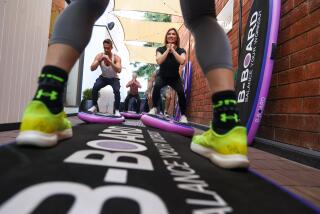There’s Gain Without Pain in the ‘Liquid Weight Room’
- Share via
A confession. In terms of exercise, I tend to shy away from swimming. It involves too much hassle for my liking. The chlorine reddens your eyes, dries out your skin and turns your hair green. Then you have to wash and blow-dry your hair, so you can’t just get from exercise to your life as quickly as I prefer.
My attitude changed--it had to--after I pulled my hamstring, because regular exercise was nearly impossible. Like a lot of professional athletes, whose rehab programs are built around water exercise, I was willing to take the plunge.
I know, I know. The image that comes to mind is of elderly people doing flutter kicks on the side of the pool--fun, maybe, but hardly strenuous. But what I learned from Mary E. Sanders, adjunct professor of exercise science at the University of Nevada-Reno and one of the leading water fitness experts, is that water aerobics can be breathtakingly strenuous and satisfying. In short, it’s no longer a slacker’s workout.
Providing about 12 times the resistance of air, water forces every muscle in your body to work harder when you exercise in it. So a vigorous 30-minute water workout offers both muscular and cardiorespiratory benefits, making it as efficient as it is effective. Being out there in the deep end of the pool with a buoyancy belt on while mimicking the motions of sprinting for a minute at a time rivals the hardest physical activities I’ve ever done. So did squatting down in the shallow end and trying to explode out of the water as high as possible.
*
One great thing about water aerobics is the amount of stress it puts on your joints: virtually none. Which means that a workout in water can give you a thrilling endorphin rush without taking the toll on your body that high-impact workouts do.
Even better, you can regulate your level of resistance by changing the speed of your movements and adding resistance devices, like webbed gloves. As Mary says, water is “a liquid weight room.” Changing the depth of the water you’re exercising in controls buoyancy and impact; the deeper you go, the lighter your body weight feels.
A number of scientific studies confirms the incredible physiological benefits of water exercise. For one, when the chest is immersed, the water pressure gently pushes against the body, making the heart and lungs work harder. This strengthens the entire breathing and circulation system, which can make breathing easier during any activity on land. Meanwhile, blood supply to all muscles increases substantially when you’re in the water, so your muscles get more oxygen, which cuts down on soreness after exercising.
And contrary to the myth that water exercises can’t burn fat, studies show that working out vigorously in water may burn over twice the calories, minute to minute, of low-impact workouts on land. Deep-water jogging, for example, burns 11.5 calories per minute, compared to the eight calories per minute burned while jogging on land. At about nine calories a minute, walking in water burns nearly twice the calories of walking on land. In fact, after training in water, land walkers tend to increase their speed by as much as 16%, studies show.
Other studies show that aquatic exercise offers benefits that can’t really be measured: Conditioning the trunk muscle helps to stabilize the body, thereby improving coordination, balance and posture in ways that land-based exercises do not.
*
These benefits are available to everyone, since you don’t have to know how to swim to take part in water exercises. With all of the flotation devices available, and the ability to stay back in shallow water, swimming skills remain an option. No wonder the number of health clubs offering water exercise programs--aerobics and strength--has jumped in the last three years from 30% to 46%, according to a study by IDEA, a fitness organization.
Many water exercises need no equipment at all. But you can increase the intensity and variety of your workout with some inexpensive equipment like webbed gloves, non-buoyant dumbbells and swim fins. You can also provide buoyancy and support for yourself with belts and those colorful, ubiquitous foam “noodles,” enabling you to be more creative with your selection of exercises. (Water exercise products are available at most sporting goods stores.)
Despite my aversion to chlorine, I’ve happily added water aerobics to my menu of fitness choices. Now, with my tight-fitting swim cap, goggles and extra-strength moisturizing lotion, I’m off to, as my good friend Ghada puts it, “ripple” in my “liquid weight room.”
*
Copyright 1999 by Kathy Smith
Kathy Smith’s fitness column appears weekly in Health. Reader questions are welcome and can be sent to Kathy Smith, Health, Los Angeles Times, Times Mirror Square, Los Angeles, CA 90053. If your question is selected, you will receive a free copy of her new video, “Kickboxing Workout.” Please include your name, address and a daytime phone number with your question.


